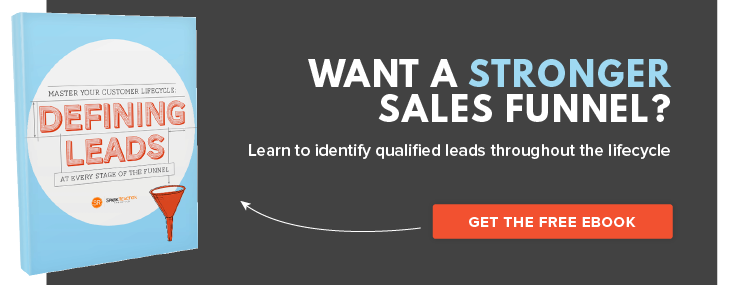
Not all keywords are created equal. Some, like "marketing," draw in huge crowds of searchers each month. Others, like "marketing tips for small shoe store companies," might squeak out a couple hits.
As marketers, we're often conditioned to go after attainable high-volume keywords. You know, the kind that pull in over a hundred Google searches per month? The rationale seems sound: We'll attract more traffic, generate more leads, and close more customers. More clicks = more business, right?
Not always. We always knew that targeting some low-volume keywords was a sound strategy, but one surprising discovery backed it up with cold, hard evidence. We dug into one client's keyword strategy and found that a forgotten low-volume keyword was generating some of their most highly converting leads.
This goes against the "more clicks = more customers" convention. But when logical assumptions and data go head-to-head, data always wins.
Here's how we improved conversions with low-volume keywords, and how you can make them work for your own strategy.
Low lead conversion with a "typical" keyword strategy
(Editor's note: Our experience was based on one client's experience, but for privacy purposes, we'll refer to them as Client A; and we have changed keyword examples.)
We began an inbound partnership with Client A, a content management system for churches, and all was going according to plan.
We implemented an inbound marketing roadmap with Client A and devised a keyword strategy based on industry norms: keywords that had high searches (at least 140 a month) and low ranking difficulty (under 70). We kept buyer personas in mind, considering who the target customers were.
Download the free eBook, "Inbound Marketing: Blueprint to Your Success," to learn how keywords generate qualified leads in an inbound marketing strategy.
We developed a list of keywords that hit the mark. Then, we set off developing content and campaigns around them. Our main focus was especially high-volume keywords (a few thousand searches a month) — we were shooting for the stars, and hoping for big wins in organic traffic.
Then we began implementation. We pulled out all the inbound stops for optimization. We blogged, wrote ebooks, posted on social media, hit "send" on email campaigns, and began workflows for engaging leads.
Traffic... but not conversions
Thanks to our efforts in high-volume keywords, we moved Client A from a 100+ ranking for high volume keywords to the top of Google in just eight weeks. Cue the celebration! But even though traffic was solid, we weren't seeing astounding organic lead conversion success from these high-volume keywords.
This meant we were hitting all the keyword stops, but not converting traffic to new leads. We were generating traffic, yes, but not necessarily the most ready-to-convert traffic... and that's where a forgotten low-volume keyword saved the day.
Low-volume, highly targeted
Recently in Client A's website, we found a year-old, untouched landing page that was converting at a miraculous 50%. (For a visual, picture a gleaming treasure chest buried in dust). The offer had been developed before our partnership began — months and months ago — but was quietly converting leads all along.
Many of Client A's offers convert well, but this landing page was especially high. So we dug into the landing page metrics to find where all the traffic was coming from. The surprising (or, not so surprising) answer was organic traffic: the evergreen goldmine of marketers. 50% of this highly converting traffic was coming in for free via organic, and these people were practically diving down the funnel.
We audited the content offer and found that it was on the first page of Google results for the keyword "church icons." We did a collective "huh?" This low-volume keyword didn't fit the criteria for a typical target... after all, it had fewer than 10 searches per month. By definition, this wasn't a keyword we were going to invest content creation into. It just didn't seem worthwhile.
Even so, 21% of the people it attracted each month were becoming brand new contacts. This offer was an incredible source of traffic-to-lead conversion, especially compared to many of Client A's offers that mainly reconverted existing leads.
How did it work so well? Let's dig in.
Why it worked
Since the keyword "church icons" was so specific, it's unlikely to show up as a recommended keyword in any keyword tool. In fact, it was labeled as a "low volume" keyword in our HubSpot portal, meaning you could count monthly searches on two hands. But the interesting thing was that those handfuls of monthly leads were piling up. And this is where you need to break from convention and go with your gut.
The successful lead conversion of this keyword owes itself to two things: clarity and relevancy.
1) Clarity
What do we mean by clarity? Since this keyword was so specific, visitors searching the term and then clicking through the link knew exactly what they were going to get.
These people were directly searching for something, and so they were brought to a landing page just for that purpose. They skipped the "blog post" and "CTA" steps entirely — no need! They were already convinced they needed the offer, and Client A just needed to deliver.
2) Relevancy
The offer itself had the perfect chemistry of being relevant and useful — mainly because it was perfect for Client A's buyer persona. These people were looking to improve their websites themselves, so they searched for design elements (icons) related to their industry (Church).
When they landed upon such a relevant resource, they naturally engaged with the landing page. Submitting the form was a breeze. And a form submission put them on an educational track to begin thinking about their problem (ineffective websites) in terms of a solution — like investing in a customized CMS! (AKA, Client A's service.)
Use low-volume keywords in your own strategy
In your own keyword strategy, take a closer look at your high volume keywords and the conversion rates they are generating. They might be bringing in high traffic, but is it clear which content you should be producing to match the keyword's intent?
For example, when someone searches for the high-volume “project management,” they could be looking for information on how to implement project management, or what the definition of project management is, or which methods are best for small business project management, or how to find tools to improve internal project management. Your content might hit the mark, or it might not. And for many of those questions, your service might not even be the answer.
On the other hand, someone who searches something like “church icons” is pretty clearly looking for, well, church icons! And design elements naturally tied into Client A's mission: better church websites.
This keyword was a ready-for-conversion opportunity — the dream Google result. It proved our presumed hypothesis that we could pump effort into high-volume keyword optimization, but that those keywords weren't necessarily clear for searchers... meaning potentially irrelevant offers and fewer conversions.
But is it worth it? Consider this equation:
- A keyword with 100 monthly searches that converts 20% of traffic, of which only 5% are qualified leads = 1 potential SQL/month.
- A keyword with 10 monthly searches that converts 50% of traffic, all of which are qualified leads = 5 potential SQLs/month.
The key is in finding the right low-volume, long-tail keywords that bring in qualified leads — and pairing them with just the right offer. Here's how it can be done.
1) Brainstorm your offer
Think: Which tools, handbooks, or other freebies can you offer potential leads? They don't need to be directly related to your product (after all, Client A isn't a design company specializing in icon design), but they must interest your buyer personas and eventually tie back to your product. Think of pain points for your ideal customers, and how you can easily solve them with some freebie or resource.
(If you're stuck, you can skip directly to step 2 to start with relevant keywords and work backwards to identify an offer idea.)
2) Find the right phrase with keyword research
Run these ideas through a keyword tool to find potentially related keywords. Remember: clarity and relevancy are key. And if you've got a good idea, don't mind the "search volume" after all!
3) Craft the offer
Spend some time using your resources to get this offer just right. It doesn't need to be complex: simple checklists or handy how-to worksheets can work wonders for leads.
4) Optimize your landing page
Craft your landing page accordingly. Make sure to optimize the landing page around the keyword with best practices.
Takeaway
Don't put all your eggs into the common benchmarks for keywords: high volume, low difficulty keywords. It's important to spread your strategy across different options. After all, some of the best lead conversion opportunities come from highly relevant, low-volume keywords. (That being said, don't put all your eggs in the low-volume basket, either! Aim for a diversified strategy.)
The best way to find those opportunities is to understand your buyer personas and what your most qualified traffic is searching for. This affirms our stance that it's not necessarily web traffic that matters, but rather the right web traffic.
Download the free eBook below to learn how an inbound marketing blueprint helps you nail down your target customer — letting you generate qualified leads and more customers.
from HubSpot Marketing Blog http://blog.hubspot.com/marketing/lead-conversion-case-for-low-volume-keywords
Via http://blog.hubspot.com/marketing/lead-conversion-case-for-low-volume-keywords

No comments:
Post a Comment